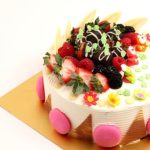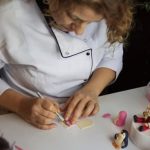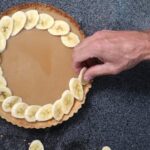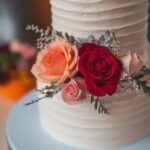Cake decoration is an integral part of the baking process, transforming a plain dessert into a work of art. The beauty and intricacy of a well-decorated cake can captivate anyone’s attention and evoke admiration. But have you ever wondered how long it takes to create these stunning confections?
In this article, we will delve into the art and science behind cake decoration, exploring the factors that impact the time required to decorate a cake. We will uncover the significance of cake decoration in baking and discuss the allure of beautifully decorated cakes. Additionally, we will provide a brief overview of the various elements that contribute to the duration of cake decoration.
Decorating a cake is not just about adding a few dollops of frosting or sprinkles on top-it involves careful planning, skillful execution, and endless creativity. The way a cake is decorated can completely transform its appearance and elevate it from being just another sweet treat to an awe-inspiring masterpiece.
Throughout this article, we will explore the basics of preparing a cake for decoration, such as choosing the right type of base and prepping it through leveling, filling, and stacking. We will also delve into planning out your design by sketching different ideas and choosing from various decorating techniques and tools.
Whether you’re an aspiring baker looking into cake decoration for the first time or an experienced decorator searching for ways to streamline your process, understanding how long it takes to decorate a cake is essential. So let’s dive in.
Understanding the Basics
Preparing the cake for decoration is an essential step in the cake decorating process. This section will delve into the details of selecting the right type of cake base, prepping the cake, and the importance of chilling or freezing it for easier handling and stability.
Choosing the Right Type of Cake Base
The first step in preparing a cake for decoration is selecting the appropriate type of cake base. Different types of cakes have different textures and consistencies, which can affect how well they hold up during decoration. For example, a dense pound cake may be better suited for elaborate designs that require intricate detailing, while a lighter sponge cake may be more suitable for simpler designs.
It’s also important to consider the flavor profile of the cake base and how it complements the overall design. Chocolate, vanilla, and red velvet are popular choices that can serve as a blank canvas for a variety of decorations.
Prepping the Cake: Leveling, Filling, and Stacking
Before diving into decoration, it is crucial to properly prep the cake. This involves leveling off any domed tops with a serrated knife or cake leveler to ensure an even surface. Once leveled, you can proceed to fill any layers with frosting or other desired fillings for added flavor and moisture.
After filling, if your design calls for multiple tiers or layers, it is important to stack them securely. Using dowels or other support systems can help maintain stability and prevent any mishaps during transportation or display.
Chilling or Freezing the Cake for Easier Handling and Stability
Chilling or freezing the cake after prepping is a common practice among seasoned decorators. This step helps firm up the structure of the cake, making it easier to handle during decoration without causing crumbly messes. It also helps to lock in moisture and keep the flavors intact.
To chill the cake, you can place it in the refrigerator for a few hours or overnight. Freezing the cake is also an option, but make sure it is double-wrapped in plastic wrap and sealed in an airtight container to prevent any unwanted odors or flavors from seeping in.
Planning the Design
Design planning is a crucial step in cake decoration as it sets the foundation for a successful and visually appealing result. Taking the time to sketch out your ideas and choose the right techniques can make all the difference in creating a stunning cake. Here are some key considerations when planning the design of your cake.
The Importance of Design Planning
Before diving into decorating your cake, it is important to have a clear vision of what you want to achieve. Design planning allows you to map out every detail, from color schemes to specific decorations, ensuring that your end result matches your initial concept. By having a plan in place, you can also organize your decorating process more effectively and avoid any last-minute surprises or mistakes.
When planning your design, consider factors such as the occasion or theme of the cake, as well as any specific requests from clients or loved ones. This will help guide your decisions on color palettes, patterns, and overall style. Additionally, take into account any special dietary restrictions or preferences that may impact certain decoration techniques or materials.
Sketching Different Cake Decoration Ideas
One effective way to plan your cake design is by sketching out different ideas before getting started. Grab a pencil and paper and allow yourself to explore various concepts and possibilities. Don’t be afraid to get creative – let your imagination run wild.
Sketching enables you to visualize how different elements will come together on your cake surface. From piping patterns to fondant sculptures, mapping them out on paper gives you an idea of their placement and scale. It also helps identify any potential challenges or areas where adjustments may be needed before committing them to the actual cake.
Exploring Various Cake Decorating Techniques and Tools
Once you have sketched out some design options, it is time to think about the specific techniques and tools that will bring your vision to life. Familiarize yourself with various cake decorating techniques, such as piping, stenciling, or airbrushing, and consider which ones align best with your design.
Equally important is choosing the right tools for the job. Piping bags and nozzles, fondant tools, brushes, and spatulas are just a few examples of the equipment you may need to achieve your desired decorations. Research different options and experiment with them beforehand to ensure you have everything you need on hand when it’s time to decorate.
Remember that exploring new techniques and tools can be an exciting part of the cake decoration process. Don’t be afraid to step outside of your comfort zone and try something new – this is how you can take your designs to the next level.
By carefully planning your design, sketching out ideas, and considering different techniques and tools, you can set yourself up for success in cake decoration. Take the time to develop a clear vision before starting the actual decorating process, as this will save you time and effort in the long run. Remember that practice makes perfect, so don’t hesitate to experiment and keep refining your skills as you continue on your cake decoration journey.
Getting Started
When it comes to decorating a cake, having the right supplies is essential for achieving professional-looking results. Whether you’re a beginner or an experienced decorator, there are certain tools and materials that you’ll need to gather before you start the cake decoration process.
To help you get started, here is a comprehensive list of necessary cake decorating supplies:
Piping Bags and Nozzles
Piping bags are used for applying frosting or buttercream in various designs and patterns. They come in different sizes and materials, such as disposable plastic or reusable cloth. Nozzles, also known as tips, determine the shape and size of the decorative element. There are numerous types of nozzles available, including round, star, petal, leaf, and specialty tips.
Fondant Tools
If you plan on using fondant to cover your cake or create intricate decorations, you’ll need some specialized tools. These may include a rolling pin for flattening the fondant, smoothing tools for achieving a polished finish, embossing mats or cutters for adding patterns or shapes, and modeling tools for shaping intricate details.
Colors and Edible Decorations
To bring your cake to life with vibrant colors or special effects, you’ll need food coloring gels or pastes that can be mixed to achieve custom shades. Additionally, edible glitter or luster dust can add sparkle and shine to your creations. Other decorative elements like sugar flowers, figurines, sprinkles, or edible pearls can further enhance the overall look of your cake.
While it’s important to gather all the essential supplies for cake decoration, finding affordable yet high-quality options can make a big difference. Consider looking for deals online or locally at baking supply stores to save money without compromising on quality.
With these necessary supplies in hand, you’ll be well-equipped to start your cake decorating journey. Remember, assembling a collection of reliable tools and materials is an investment that will pay off in the long run, as it allows you to create beautifully decorated cakes with ease and precision.
The Time Factor
Decorating a cake is not only an art but also a science. The time it takes to decorate a cake can vary greatly depending on several factors. Understanding these factors can help bakers plan their time more effectively and create beautifully decorated cakes.
One of the main factors that affect the duration of cake decoration is the complexity of the design. Simple designs with minimal details and decorations will generally take less time compared to intricate designs with numerous intricate elements. It’s important for decorators to consider their own skill level and experience when choosing a design, as more complex designs may require additional time and expertise.
The decorator’s experience and skill level also play a significant role in how long it takes to decorate a cake. Experienced decorators who have mastered different techniques and have a good understanding of cake decoration principles may be able to complete a design more quickly than beginners. It’s important for decorators to be realistic about their own capabilities and allow themselves enough time to complete the decoration without feeling rushed or overwhelmed.
Another factor that impacts the duration of cake decoration is the working conditions. Professional kitchens are often equipped with all the necessary tools, equipment, and supplies, which can streamline the process and save time. On the other hand, decorating cakes in a home environment may require more improvisation and preparation, which can add extra time to the overall process.
Step-by-Step
The cake decoration process is an essential part of creating a visually appealing and delicious cake. Whether you are a beginner or an experienced baker, following a step-by-step process can help ensure that your cake turns out beautifully decorated. In this section, we will explore the key steps involved in the cake decoration process.
Preparing the Cake Surface for Decoration
Before you begin decorating your cake, it is important to properly prepare the surface. This ensures that the decorations adhere well and create a smooth base. One common method is to cover the cake with buttercream frosting or fondant.
Applying Buttercream or Fondant for a Smooth Base
Buttercream frosting is a versatile option that provides a delicious taste and allows for piping of intricate designs. To create a smooth base with buttercream frosting, start by applying a crumb coat to prevent any loose crumbs from mixing into the final layer of icing. Once the crumb coat has chilled, apply another layer of buttercream using an offset spatula or bench scraper to achieve a smooth surface.
Fondant is another popular choice for creating a smooth base. Rolled fondant can be draped over the cake and smoothed out to create a sleek finish. It can be purchased pre-made or made from scratch using marshmallows or gelatin. To apply rolled fondant on your cake, make sure you have properly sized pieces and gently press and smooth them onto the surface.
Adding Details and Accents Using Piping Bags and Nozzles
After applying the base layer of buttercream or fondant, it’s time to add details and accents to your cake using piping bags and nozzles. Piping bags are used to pipe various designs such as borders, flowers, rosettes, and writing onto the cake surface.
Piping nozzles come in different shapes and sizes, each producing unique patterns or shapes. Some common nozzle types include round, star, leaf, and petal. Experimenting with different piping techniques and nozzles can help create stunning patterns and designs on your cake.
Decorative Touches
Fondant is a versatile and popular choice for cake decoration due to its smooth and polished finish. It allows decorators to create intricate designs and add depth and texture to their cakes. Rolling out the fondant, coloring it, and shaping it can be time-consuming but rewarding steps in the cake decorating process.
To work with fondant, start by kneading it until it becomes soft and pliable. This will make it easier to roll out later on. Dust a clean surface with powdered sugar or cornstarch to prevent sticking, and use a rolling pin to roll the fondant into a thin, even sheet. Carefully lift the rolled-out fondant using a rolling pin or your hands, then drape it over the cake’s surface.
Once the fondant is on the cake, gently smooth it out using your hands or a fondant smoother tool. Smooth any wrinkles or air bubbles that may have formed during the process. Trim off any excess fondant from the edges of the cake using a sharp knife.
Coloring fondant opens up endless possibilities for creating unique designs. Gel food coloring is recommended as it won’t change the consistency of the fondant. Use toothpicks or small paintbrushes to add color gradually and mix until desired hues are achieved.
Edible glitter and lustre dust can also enhance a cake’s overall appearance by adding sparkle and shine. These decorative elements come in various colors and can be brushed directly onto fondant-covered cakes using clean brushes or dusted with a dry brush.
Incorporating additional decorative elements such as sugar flowers or figurines can further elevate the design of your decorated cake. These additions often require advanced skills in sugarcraft techniques but can truly make a cake stand out.
With patience, practice, and creativity, anyone can master working with fondant and other decorative touches to create stunning cakes that are sure to impress. Experimentation is key here; try different techniques, colors, and design ideas to find your personal style. The satisfaction of seeing a beautifully decorated cake is well worth the time and effort put into the process.
Timing Challenges
Decorating a cake can be a time-consuming process, but with the right strategies, you can streamline the decoration process without sacrificing quality. Whether you’re a beginner or a professional, these time-saving tricks will help you create beautifully decorated cakes in a more efficient manner.
One key strategy for efficient cake decoration is to plan ahead and be organized. Before you begin decorating, gather all the necessary tools and supplies, ensuring everything is within reach. This will save you precious time searching for items while working on the cake. Additionally, sketch out your design in advance and visualize each step of the decoration process. Having a clear plan will help you work more efficiently and reduce any unnecessary backtracking.
Another time-saving technique is to prioritize your tasks based on urgency and difficulty level. Start by focusing on the elements that require the most attention or have specific timing requirements, such as intricate piping details or delicate fondant work. By tackling these challenging aspects first, you avoid potential mishaps that could ruin your entire design later on.
When it comes to icing your cake, consider using buttercream instead of fondant if time is a constraint. Buttercream can be applied quickly and easily, providing a smooth base for further decoration. If fondant is preferred, opt for pre-made sheets instead of making it from scratch to save considerable preparation time.
Lastly, practice makes perfect when it comes to improving efficiency in cake decoration. The more experience and skill you develop, the better you’ll become at managing your time during the decoration process. Learning techniques like multi-tasking and working with multiple layers simultaneously can significantly speed up your work without compromising quality.
Case Studies
In this section, we will delve into some real-life examples of cake designs and the timeframes it typically takes to decorate them. It is important to note that these timeframes can vary depending on individual skill level and experience, as well as the complexity of the design. However, these case studies will provide a general idea of the time commitment involved in creating beautifully decorated cakes.
Example 1: Simple Buttercream Design
For a simple buttercream cake with minimal design elements such as smooth icing and piped borders, the decoration process generally takes around 1-2 hours. This includes prepping the cake, applying and smoothing the buttercream, and adding basic piping details. This type of design is perfect for beginners or those with limited decorative skills.
Example 2: Intricate Fondant Design
On the other end of the spectrum, an intricate fondant design that involves detailed sculpting, painting, and intricate patterns can take several hours or even days to complete. For example, a fondant wedding cake with handcrafted sugar flowers, lace detailing, and intricate piping work may require 10-20 hours or more spread over several days. This type of design is best suited for experienced decorators who can dedicate ample time to each intricate element.
Example 3: Customized Character Cake
Creating a customized character cake requires both artistic skills and attention to detail. From shaping fondant characters to adding vibrant colors and textural details using various edible decorations, this type of design typically takes about 4-6 hours for skilled decorators. However, beginners may find it more time-consuming due to their learning curve.
These examples showcase the wide range of timeframes required for different cake designs. However, it is important to remember that practice and experience play a significant role in speeding up the decorating process without compromising quality.
| Example | Type of Design | Estimated Timeframe |
|---|---|---|
| Example 1 | Simple Buttercream Design | 1-2 hours |
| Example 2 | Intricate Fondant Design | 10-20+ hours over several days |
| Example 3 | Customized Character Cake | 4-6 hours (for skilled decorators) |
Each cake design is unique, and the time required can be impacted by factors such as the level of detail, skill level, and working conditions. It’s essential for decorators to plan their time effectively and allow for additional hours or days if necessary. Additionally, breaking down the decoration process into steps and focusing on one element at a time can help streamline the overall duration.
Remember, each cake decoration project is an opportunity to develop your skills and express your creativity. The sense of pride and satisfaction that comes from creating a masterpiece cake that brings joy to others is well worth the investment of time and effort.
Conclusion
In conclusion, the art of cake decoration is a time-consuming but rewarding process that allows bakers to create visually stunning masterpieces. Throughout this article, we have explored the various factors that impact the time required for cake decoration, from preparing the cake base to adding decorative touches and incorporating different techniques.
While the complexity of the design, experience level of the decorator, and working conditions all play a role in determining how long it takes to decorate a cake, it is clear that time spent on this craft is well worth it.
Creating beautifully decorated cakes not only adds an aesthetic appeal but also showcases the skill and creativity of the baker. From sketching different design ideas to gathering essential supplies and adding intricate details using piping bags and nozzles, each step in the cake decoration process contributes to the final masterpiece. It is through careful planning and execution that these creations come to life.
Despite the time commitment involved in cake decoration, it is important for aspiring decorators to experiment and find their own pace. Whether you are a beginner or a seasoned professional, practicing efficient time-saving tricks can help streamline the decoration process without sacrificing quality. Additionally, being aware of common pitfalls and strategies for avoiding them can further enhance efficiency.
Ultimately, creating beautifully decorated cakes brings immense satisfaction and pride. The joy of seeing your vision come to life on a delicious canvas cannot be overstated. So embrace the artistry and science behind cake decoration, take your time with each step of the process, and enjoy every moment spent creating edible works of art.
Frequently Asked Questions
How far in advance should you decorate a cake?
The ideal time to decorate a cake can vary depending on factors such as the type of decoration, the complexity of design, and personal preference. However, it is generally recommended to start decorating a cake at least a day in advance. This allows enough time for the baked cake layers to cool completely before being handled and decorated.
Additionally, some decorations may require setting or drying time, such as fondant accents or gum paste flowers. By giving yourself ample time to decorate the cake, you can work with greater precision and attention to detail while ensuring that the final product is thoroughly set and ready for presentation.
How long does a professional cake take to make?
The timeline for making a professional cake can significantly differ depending on various factors such as size, design complexity, and specific recipe requirements. However, in general, a professionally made cake typically takes several hours or even days from start to finish. This includes tasks such as measuring and mixing ingredients, preparing batter and baking the cake layers, allowing them to cool completely before levelling and layering them with fillings or frosting.
Decorating a professional cake may also involve additional steps like icing application, fondant work or piping intricate designs. Each stage requires careful planning and execution in order to create an exquisite final product that meets or exceeds professional standards.
Can you bake and decorate a cake in one day?
Yes, it is possible to bake and decorate a cake all in one day if time constraints or other circumstances make it necessary. However, this will largely depend on the specific recipe being used and the complexity of the desired decoration. Baking a cake can often be accomplished within a few hours – including mixing ingredients, pouring batter into pans, baking them until done, then allowing them to cool completely before applying any frosting or fillings.
Once cooled down sufficiently, you can proceed with decorating by applying buttercream frosting or other desired icing techniques that do not require extensive setting times like fondant work does. While it may be more challenging due to limited time for drying or setting, it is indeed possible to bake and decorate a cake in one day by carefully managing your time and prioritizing the essential steps of the process.

Welcome to my blog about home and family. This blog is a place where I will share my thoughts, ideas, and experiences related to these important topics. I am a stay-at-home mom with two young children. I hope you enjoy reading it! and may find some helpful tips and ideas that will make your home and family life even better!





